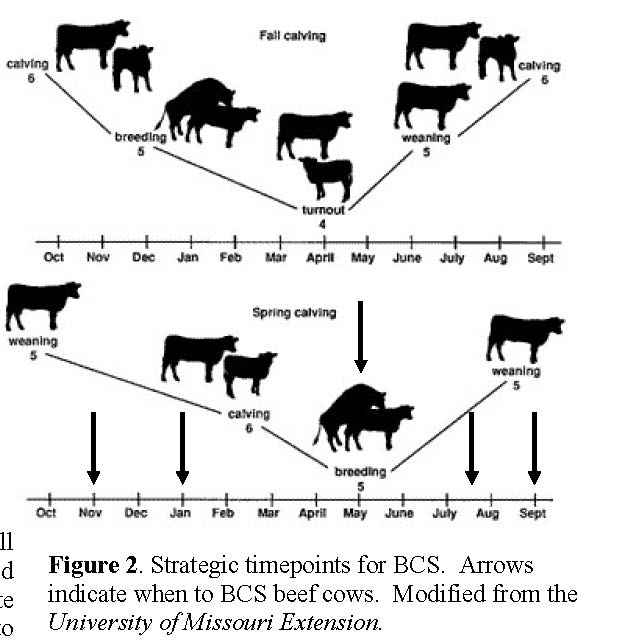Body Condition Scores
Body condition scoring is a management tool that can be used to evaluate the nutritional status of beef cattle. The tool uses a numeric score, 1 to 9, for evaluating the fleshiness, or body energy reserves, of the beef cow and does not require the gathering and working of cows. Body condition score utilizes a score from 1 to 9, with 1 being emaciated and 9 being very obese, with the ideal BCS being 5 to 6. Areas considered when evaluating body condition score include the brisket, back, tail head, hooks, pins, and ribs (Figure 1).

Body condition scoring should be measured throughout the year at strategic timepoints during the production cycle. Body condition should be evaluated at the beginning of the breeding season, 90 days prior to calving, calving, late summer, weaning, 45 days after weaning, and fall (Figure 2.) Maintaining the optimum BCS throughout year is crucial to maintaining reproductive efficiency and cow and calf health.

Evaluating BCS 90 days prior to calving will allow those thin cows to be separated and fed accordingly to improve body condition. Late gestation adds increased stress on the cow due to the rapid growth of the calf. Having adequate body condition at calving reduces the stress on both the cow and calf. Cows at optimum body condition at calving produce healthier calves and are able to maintain peak lactation compared with thin cows.
If cows are thin at calving, the pre-calving nutrition program or weaning dates may need to be changed. It is difficult for thin cows to gain body condition immediately after calving, which requires large amounts of high quality feeds, which may not be an economically viable decision.
Maintaining adequate BCS reduces postpartum interval compared with thin cows and will improve pregnancy rates after a 90 day breeding season. A BCS 5 or 6 improves pregnancy rates drastically compared with a BCS of 4. Therefore, having cows in good body condition during the breeding season improves pregnancy rates.
Measuring BCS between breeding and weaning (late summer) allows for nutritional adjustments to be made. If cows are thin heading into weaning, early weaning can be considered to reduce the stress on the cow. Early weaning of thin cows lets those cows regain condition before heading into the winter months and the increased nutrient demands during late gestation.
Analyzing BCS at weaning allows for thin cows to be separated and fed apart from the fleshy cows. This will help the thin cows regain body condition before heading into fall. This is also a time to focus on young cows that are weaning their first calf, as they are more likely to be thin compared to the older cows.
Evaluating body condition 45 days after weaning gives you a good idea if cows are regaining condition after weaning. If thin cows are not regaining body condition, then nutritional adjustments can be made before entering the winter months.
Condition scoring cows during the fall allows for the critical evaluation of feed resources. Most years, the fall months include reduced pasture availability and quality, which makes it difficult for cows to regain condition. Those cows that are thin heading into winter can be fed separately with supplemental feeds to improve body condition.
|
Key points for body condition scoring beef cows |
|||||||||
|
|
Body Condition Score |
||||||||
|
Reference Point |
1 |
2 |
3 |
4 |
5 |
6 |
7 |
8 |
9 |
|
Physically weak |
Yes |
No |
No |
No |
No |
No |
No |
No |
No |
|
Muscle atrophy* |
Yes |
Yes |
Slight |
No |
No |
No |
No |
No |
No |
|
Outline of spine visible |
Yes |
Yes |
Yes |
Yes |
Slight |
No |
No |
No |
No |
|
Outline of ribs visible |
All |
All |
All |
3-5 |
1-2 |
0 |
0 |
0 |
0 |
|
Fat in brisket and flanks |
No |
No |
No |
No |
No |
Some |
Full |
Full |
Full |
|
Outline of hip and pin bones visible |
Yes |
Yes |
Yes |
Yes |
Yes |
Yes |
Slight |
No |
No |
|
Fat in udder and patchy fat around tail head |
No |
No |
No |
No |
No |
No |
No |
Slight |
Yes |
|
*Muscles of rump, loin, and hindquarter are concave, indicating loss of muscle tissue. |
|||||||||
|
Adapted from Pruitt and Momont, 1988. |
|||||||||
